In-line switches offer convenient control directly on the power cord, ideal for temporary setups or easy access without modifying devices, while panel mount switches are designed for permanent installation on control panels, providing durability and seamless integration for professional applications. Explore the rest of the article to determine which switch best suits your specific needs.
Comparison Table
| Feature | In-line Switch | Panel Mount Switch |
|---|---|---|
| Installation Location | Inline on the power cable | Mounted on equipment panel or enclosure |
| Accessibility | Easy access on cable for quick operation | Fixed location for consistent control |
| Durability | Less durable, exposed to handling | More robust, protected by panel housing |
| Application | Portable devices, temporary setups | Industrial machines, permanent installations |
| Wiring Complexity | Simple, inline with existing cable | Requires panel cutout and secure mounting |
| Cost | Generally lower cost | Higher cost due to installation and hardware |
Introduction to In-line and Panel Mount Switches
In-line switches are compact electrical components integrated directly into a cable, offering easy control over devices without requiring panel installation. Panel mount switches are designed for permanent installation on control panels or equipment surfaces, providing durable and accessible operation in industrial and consumer applications. Your choice between these switches depends on the desired mounting location, ease of access, and the specific device control requirements.
Understanding In-line Switches: Features and Applications
In-line switches are compact electrical switches installed directly on the power cord, allowing convenient control without accessing the device or wall outlet. They feature simple toggle or rocker mechanisms designed for easy operation in lighting, small appliances, and DIY projects. Commonly used in lamps and holiday decorations, in-line switches offer portability and straightforward installation compared to panel mount switches.
Exploring Panel Mount Switches: Characteristics and Uses
Panel mount switches feature a design that enables secure installation directly onto control panels, offering robust durability and easy accessibility for industrial equipment and machinery. Their compact form factor supports various applications including automation systems, medical devices, and aerospace controls, where reliable, high-performance switching is critical. These switches often come with sealed or waterproof options, enhancing resistance to dust, moisture, and harsh environments, making them ideal for rugged and precision-demanding contexts.
Key Differences Between In-line and Panel Mount Switches
In-line switches are installed directly on the electrical wire, allowing for convenient control of devices without modifying the equipment housing, making them ideal for portable or temporary setups. Panel mount switches are fixed onto a device's control panel, offering a more permanent, integrated solution with often greater durability and aesthetic integration. Key differences include installation location, ease of access for repairs or replacements, and suitability for various applications based on environmental exposure and design requirements.
Installation Methods: In-line vs Panel Mount
In-line switches are installed directly along the cable, allowing for quick integration without altering the device's housing, making them ideal for external control and easy replacements. Panel mount switches require a cutout in the device panel, offering a more permanent and professional installation with secure mounting and clean aesthetics. Your choice depends on whether you prioritize straightforward cable integration or a fixed, visually streamlined switch setup.
Durability and Environmental Considerations
Panel mount switches offer superior durability due to their robust housing that protects internal components from dust, moisture, and mechanical wear, making them ideal for harsh industrial environments. In-line switches, while convenient for quick access and installation on cables, often have less protective casing and are more susceptible to damage from physical stress and environmental factors. Selecting a switch depends on the application's exposure to elements, with panel mount switches preferred for environments requiring high resistance to water, dust ingress, and mechanical impact.
Safety and Accessibility Aspects
In-line switches provide enhanced safety by isolating the electrical circuit within the cable, reducing exposure to live parts and minimizing the risk of accidental contact. Panel mount switches offer superior accessibility for frequent operation and maintenance, featuring secure mounting on control panels that protect internal wiring from environmental hazards. Both switch types comply with industry safety standards, but panel mount switches often incorporate additional protective features such as sealed enclosures for high durability in industrial settings.
Cost Comparison: In-line Switch vs Panel Mount Switch
In-line switches generally offer a lower cost due to simpler installation and fewer materials needed compared to panel mount switches, which require precise mounting and often involve higher labor expenses. Panel mount switches provide enhanced durability and aesthetic integration for control panels, potentially justifying their higher upfront investment with long-term reliability. Assess your project requirements to choose the switch type that balances upfront costs with performance benefits for your application.
Choosing the Right Switch for Your Application
In-line switches are ideal for applications requiring easy installation and portability, often used with power cords for household appliances or tools. Panel mount switches offer a secure, fixed mounting solution, suited for control panels in industrial or automotive environments where durability and accessibility matter. Choosing the right switch depends on your need for mobility, space constraints, and the operating environment of your device.
Conclusion: Which Switch Type Suits Your Needs?
In-line switches offer easy installation and flexible placement within your device's power cord, making them ideal for applications requiring convenient access and simple control. Panel mount switches provide a more permanent, professional setup by integrating directly into equipment panels, ensuring durability and a clean appearance for devices frequently accessed by users. Your choice depends on whether you prioritize portability and ease of installation with in-line switches or long-term reliability and aesthetic integration with panel mount switches.
In-line switch vs Panel mount switch Infographic

 solderic.com
solderic.com